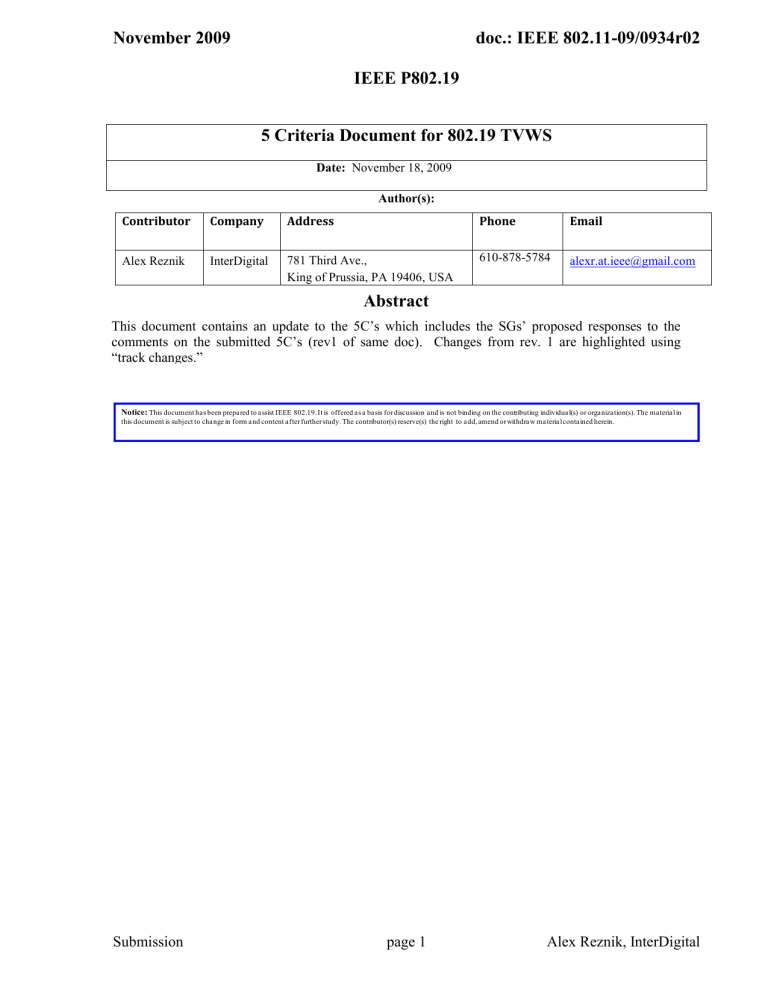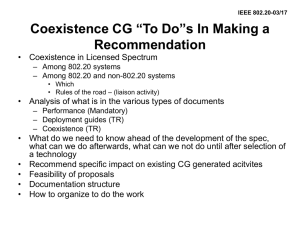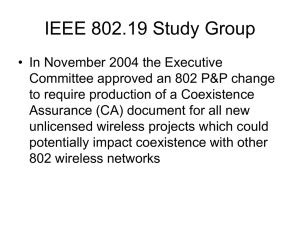November 2009 doc.: IEEE 802.11-09/0934r02 IEEE P802.19

November 2009 doc.: IEEE 802.11-09/0934r02
IEEE P802.19
5 Criteria Document for 802.19 TVWS
Date: November 18, 2009
Author(s):
Contributor Company Address Phone Email
Alex Reznik InterDigital 781 Third Ave.,
King of Prussia, PA 19406, USA
610-878-5784 alexr.at.ieee@gmail.com
Abstract
This document contains an update to the 5C’s which includes the SGs’ proposed responses to the comments on the submitted 5C’s (rev1 of same doc). Changes from rev. 1 are highlighted using
“track changes.”
Notice: This document ha s been prepa red to a ssist IEEE 802.19. It is offered a s a ba sis for discussion a nd is not binding on the contributing individua l(s) or orga niza tion(s). The ma teria l in this document is subject to cha nge in form a nd content a fter further study. The contributor(s) reserve(s) the right to a dd, amend or withdra w ma teria l conta ined herein.
Submission page 1 Alex Reznik, InterDigital
November 2009 doc.: IEEE 802.11-09/0934r02
Five Criteria
17.5.1 Broad Market Potential
A standards project authorized by IEEE 802 shall have a broad market potential.
Specifically, it shall have the potential for: a) Broad sets of applicability. The need for a coexistence standard is demonstrated by the past and ongoing work in IEEE 802.11, IEEE 802.22, IEEE 802 ECSG on TVWS and the IEEE 802.19 TVWS SG as well as new TVWS PARs. b) Multiple vendors and numerous users. Current wireless ISP services use the 900MHz, 2.45 GHz and 5GHZ bands, operating under part 15 rules using multiple and dissimilar MAC/PHY standards or air interfaces. There are many vendors of IEEE 802 wireless equipment for indoor and outdoor operation, and it is expected that there will be several offering equipment for the TVWS band. c) Balanced costs (LAN versus attached stations).
Current technology enables manufacturers to balance costs for coexistence mechanisms.
17.5.2 Compatibility
IEEE 802 defines a family of standards. All standards shall be in conformance with the
IEEE 802.1 Architecture, Management, and Interworking documents as follows: 802.
Overview and Architecture, 802.1D, 802.1Q, and parts of 802.1f. If any variances in conformance emerge, they shall be thoroughly disclosed and reviewed with 802.
Each standard in the IEEE 802 family of standards shall include a definition of managed objects that are compatible with systems management standards.
This standard will not require changes to any existing 802 MAC SAP definitions, ensuring that all LLC and
MAC interfaces are compatible to and in conformance with the IEEE 802.1 architecture, management and internetworking standards.
17.5.3 Distinct Identity
Each IEEE 802 standard shall have a distinct identity. To achieve this, each authorized project shall be: a) Substantially different from other IEEE 802 standards.
There is no other standard among IEEE 802 standards, which specifies mechanisms for coexistence among dissimilar wireless networks operating in the TV White Space Bands. b) One unique solution per problem (not two solutions to a problem).
Submission page 2 Alex Reznik, InterDigital
November 2009 doc.: IEEE 802.11-09/0934r02
There is no other standard which specifies mechanisms for collaborative coexistence among dissimilar wireless networks operating in the TV White Space Bands. c) Easy for the document reader to select the relevant specification.
The project will explain clearly its purpose and scope in the introduction section.
17.5.4 Technical Feasibility
For a project to be authorized, it shall be able to show its technical feasibility. At a minimum, the proposed project shall show: a) Demonstrated system feasibility.
The coexistence standard is envisioned to define four types of components (as discussed in the PAR):
a) Means of communication b) Protocols for exchanging information c) Set of coexistence parameters providing information about the interference environment and the set of MAC/PHY capabilities and d) Algorithms for adapting MAC/PHY parameters to enhance coexistence between networks.
With regards to each of these components, there are solutions that have proven their feasibility in the market. Examples of such solutions are as follows: a) Means of communication:
The communication between the nodes is based on other standards, either wired or wireless, and is not part of this standard. Thus the coexistence standard will be designed to take advantage of communication means that have proven their feasibility in the market. b) Protocols for exchanging information:
Every two-way communication system provides means for devices to exchange information. Examples are available both in wired and wireless domain both within and outside IEEE 802. These have demonstrated their feasibility in the market and the experiences from the use of these protocols will be used to develop the solution for this standard. c) Set of coexistence parameters:
In most of the communication systems there are means to provide information about the interference environment and device and system capabilities. Consequently as essential elements of each system they have demonstrated their feasibility in the market. d) Algorithms:
The study group acknowledges that in the algorithms area the coexistence standard may utilize some novel solutions. Moreover, there are already available solutions like radio network management and resource control systems that deal with similar issues. Those solutions have been used extensively and demonstrated their feasibility. Elements and experiences from them are expected to be valuable in the development of this standard.
Within the IEEE 802.19 TV White Space Study Group there have been a number of contributions indicating a number of technically feasible solutions. These contributions include multiple presentations to the 802.19 TVWS SG as available on Mentor https://mentor.ieee.org/802.19/documents . Some examples of the work presented may be found in the following contributions to 802.19 (all in the year
2009): 32, 34, 41, 44, 46, 49, 56, 79, 80. Techniques discussed in these contributions include collaborative TDM, FDM, CDM; DFS, Listen-Before-Talk; multi-mode solution vectors: frequency, power, time, modulation, space, priority; local database for coexistence coordination; coordinated channel assignment.
Submission page 3 Alex Reznik, InterDigital
November 2009 doc.: IEEE 802.11-09/0934r02 b) Proven technology, reasonable testing. Extensive existing knowledge of coexistence techniques will be applied to develop the TVWS coexistence standard.
c) Confidence in reliability.
Current communication technologies are mature enough to support coexistence in TVWS band.
17.5.4.1 Coexistence of 802 wireless standards specifying devices for unlicensed operation
A working group proposing a wireless project is required to demonstrate coexistence through the preparation of a Coexistence Assurance (CA) document unless it is not applicable. The Working Group will create a CA document as part of the WG balloting process. If the Working Group elects not to create a CA document, it will explain to the
EC the reason the CA document is not applicable .
This standard will enhance coexistence in the TVWS. Evaluation of the effectiveness of coexistence will be done during standard development. Since this is not a standard that defines a MAC/PHY, a CA document will not be produced by the group.
17.5.5 Economic Feasibility
For a project to be authorized, it shall be able to show economic feasibility (so far as can reasonably be estimated) for its intended applications. At a minimum, the proposed project shall show: a) Known cost factors, reliable data.
By providing a toolset of components to be used to enable coexistence in communication systems, this standard will enable system designers to select an appropriate cost/performance trade-off. Additionally, because the standard defines methods above MAC/PHY, cost of supporting this standard is expected to be minimal and incremental. Finally, network-based coexistence solution costs are amortized over millions of users further reducing per-user cost. b) Reasonable cost for performance.
It is expected that reasonable cost for performance will not increase and may decrease. c) Consideration of installation costs .
This standard will not introduce additional installation cost.
Submission page 4 Alex Reznik, InterDigital

